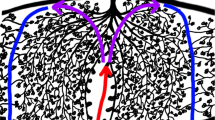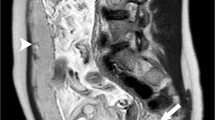Abstract
While ultrasound remains the primary imaging technique for placental evaluation, magnetic resonance imaging plays an adjunctive role in the setting of inconclusive sonographic findings. Accurate interpretation of placental MR imaging examinations requires knowledge of patient risk factors and sonographic findings in addition to familiarity with the expected normal and variant placental appearances at various stages of development. Multiplanar T2-weighted single-shot turbo/fast spin-echo sequences (e.g., rapid acquisition with relaxation enhancement [RARE] sequences such as half-Fourier acquisition single-shot turbo spin-echo [HASTE]) excel at revealing the internal structure of the placenta and underlying myometrium in addition to demonstrating fetal anatomy. When augmented with additional T1-weighted, T2-weighted, and/or balanced steady state free precession sequences, MRI becomes a powerful tool for detecting and characterizing clinically significant variants, hematomas, invasion, and neoplasms of the placenta.
Access this chapter
Tax calculation will be finalised at checkout
Purchases are for personal use only
Similar content being viewed by others
References
Elsayes KM et al (2009) Imaging of the placenta: a multimodality pictorial review. Radiographics 29(5):1371–U207
Suzuki S (2008) Clinical significance of pregnancies with circumvallate placenta. J Obstet Gynaecol Res 34(1):51–54
Pereira N et al (2013) Placenta membranacea with placenta accreta: radiologic diagnosis and clinical implications. Prenat Diagn 33(13):1293–1296
Cunningham F, Leveno KJ, Bloom SL, Spong CY, Dashe JS, Hoffman BL, Casey BM, Sheffield JS (2013) Williams obstetrics, 24th ed. McGraw-Hill, New York
Twickler DM et al (2000) Color flow mapping for myometrial invasion in women with a prior cesarean delivery. J Matern Fetal Med 9(6):330–335
Wexler P, Gottesfeld KR (1979) Early diagnosis of placenta previa. Obstet Gynecol 54(2):231–234
Rao KP et al (2012) Abnormal placentation: evidence-based diagnosis and management of placenta previa, placenta accreta, and vasa previa. Obstet Gynecol Surv 67(8):503–519
Dashe JS et al (2002) Persistence of placenta previa according to gestational age at ultrasound detection. Obstet Gynecol 99(5):692–697
Dudiak CM et al (1995) Sonography of the umbilical-cord. Radiographics 15(5):1035–1050
Di Salvo DN et al (1998) Sonographic evaluation of the placental cord insertion site. Am J Roentgenol 170(5):1295–1298
Abboud P et al (2003) Chorioamniotic separation after 14 weeks’ gestation associated with trisomy 21. Ultrasound Obstet Gynecol 22(1):94–95
Lewi L et al (2010) Monochorionic diamniotic twin pregnancies: natural history and risk stratification. Fetal Diagn Ther 27(3):121–133
Grannum PAT, Berkowitz RL, Hobbins JC (1979) Ultrasonic changes in the maturing placenta and their relation to fetal pulmonic maturity. Am J Obstet Gynecol 133(8):915–922
Bonel HM et al (2010) Diffusion-weighted MR imaging of the placenta in fetuses with placental insufficiency. Radiology 257(3):810–819
Chantraine F et al (2012) Abnormal vascular architecture at the placental-maternal interface in placenta increta. Am J Obstet Gynecol 207(3):188.e1–188.e9
Leyendecker JR et al (2012) MRI of pregnancy-related issues: abnormal placentation. Am J Roentgenol 198(2):311–320
Masselli G et al (2011) MR imaging in the evaluation of placental abruption: correlation with sonographic findings. Radiology 259(1):222–230
Linduska N et al (2009) Placental pathologies in fetal MRI with pathohistological correlation. Placenta 30(6):555–559
OBrien JM, Barton JR, Donaldson ES (1996) The management of placenta percreta: conservative and operative strategies. Am J Obstet Gynecol 175(6):1632–1638
Rosen T (2008) Placenta accreta and cesarean scar pregnancy: overlooked costs of the rising cesarean section rate. Clin Perinatol 35(3):519–529
Tikkanen M et al (2011) Antenatal diagnosis of placenta accreta leads to reduced blood loss. Acta Obstet Gynecol Scand 90(10):1140–1146
Palacios-Jaraquemada JM, Bruno CH, Martin E (2013) MRI in the diagnosis and surgical management of abnormal placentation. Acta Obstet Gynecol Scand 92(4):392–397
Rac M et al (2014) Ultrasound predictors of placental invasion: the accreta index. Am J Obstet Gynecol 210(1):S120–S120
Clark SL, Koonings PP, Phelan JP (1985) Placenta previa accreta and prior cesarean-section. Obstet Gynecol 66(1):89–92
Holt R et al (2013) Sonographic findings in two cases of complicated pregnancy in women previously treated with endometrial ablation. J Clin Ultrasound 41(9):566–569
Warshak CR et al (2006) Accuracy of ultrasonography and magnetic resonance imaging in the diagnosis of placenta accreta. Obstet Gynecol 108(3):573–581
Baughman WC, Corteville JE, Shah RR (2008) Placenta accreta: spectrum of US and MR imaging findings. Radiographics 28(7):1905–1916
Finberg HJ, Williams JW (1992) Placenta accreta: prospective sonographic diagnosis in patients with placenta previa and prior cesarean section. J Ultrasound Med 11(7):333–343
D’Antonio F, Iacovella C, Bhide A (2013) Prenatal identification of invasive placentation using ultrasound: systematic review and meta-analysis. Ultrasound Obstet Gynecol 42(5):509–517
Dwyer BK et al (2008) Prenatal diagnosis of placenta accreta – sonography or magnetic resonance imaging? J Ultrasound Med 27(9):1275–1281
D’Antonio F et al (2014) Prenatal identification of invasive placentation using magnetic resonance imaging: systematic review and meta-analysis. Ultrasound Obstet Gynecol 44(1):8–16
Kawamoto S et al (2000) Chorioangioma: antenatal diagnosis with fast MR imaging. Magn Reson Imaging 18(7):911–914
Sepulveda W et al (2000) Prenatal diagnosis of solid placental masses: the value of color flow imaging. Ultrasound Obstet Gynecol 16(6):554–558
Mochizuki T et al (1996) Antenatal diagnosis of chorioangioma of the placenta: MR features – case report. J Comput Assist Tomogr 20(3):413–416
Ahmed N et al (2004) Sonographic diagnosis of placental teratoma. J Clin Ultrasound 32(2):98–101
Miura K et al (2008) Increased level of cell-free placental mRNA in a subgroup of placenta previa that needs hysterectomy. Prenat Diagn 28(9):805–809
El Behery MM, Rasha EL, El Alfy Y (2010) Cell-free placental mRNA in maternal plasma to predict placental invasion in patients with placenta accreta editorial comment. Obstet Gynecol Surv 65(7):411–412
Salomon LJ et al (2013) MRI and ultrasound fusion imaging for prenatal diagnosis. Am J Obstet Gynecol 209(2):148.e1–148.e9
Ichizuka K et al (2012) High-intensity focused ultrasound treatment for twin reversed arterial perfusion sequence. Ultrasound Obstet Gynecol 40(4):476–478
Morita S, Ueno E, Fujimura M, Muraoka M, Takagi K, Fujibayashi M (2009) Feasibility of diffusion-weighted MRI for defining placental invasion. J Magn Reson Imaging 30(3):666–671
Author information
Authors and Affiliations
Corresponding author
Editor information
Editors and Affiliations
Rights and permissions
Copyright information
© 2016 Springer International Publishing Switzerland
About this chapter
Cite this chapter
Bailey, A.A., Twickler, D.M., Leyendecker, J.R. (2016). MRI of the Placenta. In: Masselli, G. (eds) MRI of Fetal and Maternal Diseases in Pregnancy. Springer, Cham. https://doi.org/10.1007/978-3-319-21428-3_13
Download citation
DOI: https://doi.org/10.1007/978-3-319-21428-3_13
Publisher Name: Springer, Cham
Print ISBN: 978-3-319-21427-6
Online ISBN: 978-3-319-21428-3
eBook Packages: MedicineMedicine (R0)




